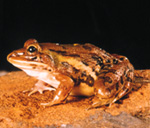Scared to leap
Scared to leap

The Himalayan newt, also called the Indian salamander, takes shelter among bamboo stumps in and around the hills of Darjeeling. It lives close to calm and still waters. During the monsoons, it feeds on algae, water beetles and bugs. After the showers, it leaps down on insect larvae, snails, slugs and earthworms. During the dry period of the year, it manages just as well by eating termites, wood lice and insects infesting rotting bamboo stumps. Its voracious appetite helps keep a check on the bugs in the area. But the newt, the only one of its kind in India , is itself threatened with extinction.
Ritwik Dasgupta, professor at the department of zoology, Darjeeling Government College, lists numerous threats to the newt. An increasing number of cattle graze in its habitat. Grazing loosens the soil, causing siltation in the water ponds. The Indian salamander, exists only in stagnant water, finds its haunt destroyed. Then, freshwater fish introduced in the ponds eat the newt's eggs. If that isn't enough to annihilate the species, the area is drained for supply of water and agriculture. Rock-blasting and quarrying takes place close to their habitat while roads criss-cross through the region. The newts scramble around, only to be crushed to death under the vehicles rushing by. For a species that is on the snack list of snakes, lizards, small animals, fish, diving birds, and even other hungry frogs that eat the eggs, it is truly besieged.
So are more than half of the 217 species of frogs, toads, salamanders (amphibians with tails) and caecilians (amphibians without legs) found in India.
Biomarkers Amphibian means







